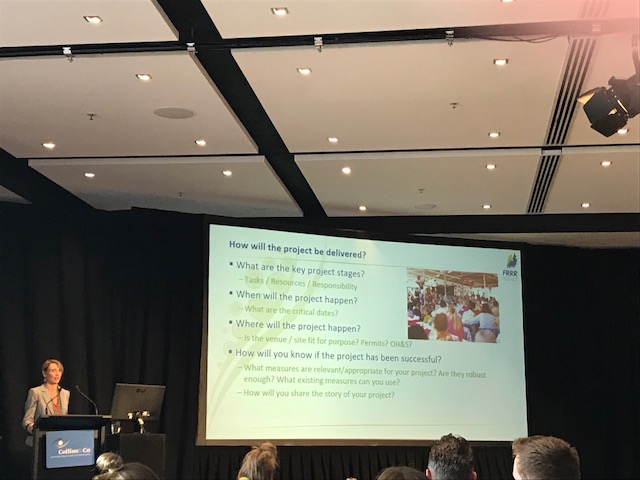Some fundraisers might find us bossy at Strategic Grants, the way we beat the drum about best practice grant-seeking. They may not want to hear it. They may have found a suitable-looking grant and want to jump in and start writing without first preparing the ground and doing the leg work. Never mind the small print, the funder’s current areas of focus, funding exclusions or all that relationship-building stuff. Let’s just whack in a grant.
To these doubting Thom(ases)/(sinas), I say simply: don’t just take our word for it, listen directly to what a funder has to say. So, it was pure nectar to my grant-seeking soul to hear Natalie Egleton, CEO at the Foundation for Rural and Regional Renewal (FRRR), speak at the sixth annual Collins & Co Conference in Melbourne last week. As Natalie pointed out, they’ve seen a lot of applications at FRRR and know what stands out. I love the honesty with which she spoke: ‘Grants may seem the easiest [among the fundraising mix] but they are hard work and bring responsibilities”
Here is a summary of some of her key tips:
• Be clear and specific early in the application about what you are seeking funding for, especially if you are requesting a contribution towards a larger project.
• Be clear and specific early in the application about what you are seeking funding for, especially if you are requesting a contribution towards a larger project.
Funders don’t want to have to wait till they read the budget to find out.
• Check a funder’s website and that there is a clear alignment: “Don’t make your project fit the guidelines, make the guidelines fit your project.”
• Show evidence of collaboration in identifying (community consultation) and addressing the issue.
• Who are the project partners and what are the efficiency gains?
• Be specific about the beneficiaries – both primary and secondary. Avoid blanket phrases such as ‘the whole community benefits’.
• What are the key stages of the project and what is the time frame? Grant writing is like writing a business case
• Retrospective funding is a no-no as, legally, that would be reimbursement not a grant.
• Evaluation – how will you determine what success looks like? Be realistic about what will be done and by whom and that you have the capability. “Measurement is about you – not the funder – how will you use the information to learn and grow?”
• Include all costs in your budget. Get quotes for larger items – don’t make them up – and triple check the figures to make sure the income and expenditure columns are equal.
Natalie also identified the challenge in finding the right grants – “trawling through newsletters can be tiring.” I was pleased to see she listed Strategic Grants in her list of recommended sources. Our GEMS (Grant Expertise Management System) can save you all that fatigue with a customised list of just the grants that are relevant to your funding needs. For further information please contact one of the SG team.

Bianca Crocker, aka the ‘Fish Chick’ (from Fish Community Solutions), spoke to us about donor engagement strategies. Although her focus was on individual donors, the same approach applies to Trusts and Foundations.
Some of her key take-aways were:
• Get to know them
• Stay in touch with newsletters, updates and social media
• Be honest and transparent. For example, if the project changes and their money is not spent as planned, tell them.
• Make them feel special and involve them. Listen to them – don’t just talk about your organisation.
• Seek their opinion.
• The most important word in fundraising is Thank You.
Frank Chamberlin from ActionWords gave some compelling writing tips for writing emails, many of which, apply to grant-writing.
• Get to the point ASAP
• Keep it simple and uncluttered
• Use plain English
• Short words are better than long ones
• Make your sentences shorter and vary the lengths of your sentences
• Allocate time and space – writing takes time
• If you can, sleep on it and re-read the next day before sending.

